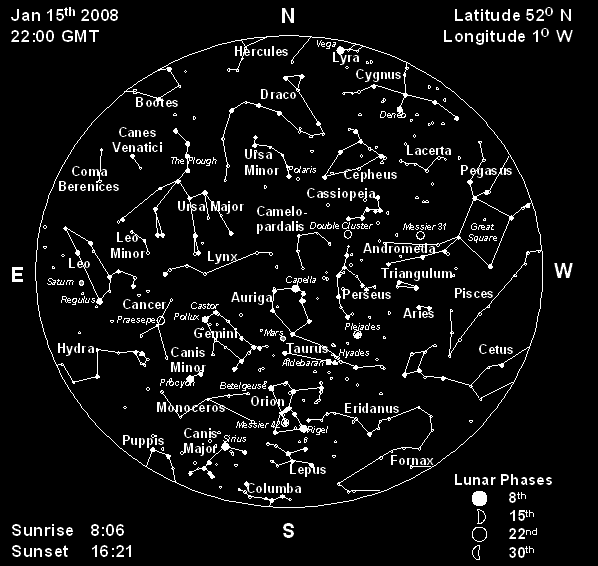THE NIGHT SKY - JANUARY 2008
CLICK HERE TO DOWNLOAD A "PRINTER FRIENDLY" PDF FILE VERSION (27KB)
By ten o’clock in mid-month the stars of autumn, led by the Great Square of Pegasus are setting in the west but the fine trio of Perseus, Andromeda and Cassiopeia are still fairly high up. The southern sky is dominated by Orion and his retinue of splendid winter groups, such as Taurus, Gemini and Auriga. Below the three belt stars of Orion, look for a misty patch of light. This is the Great Orion Nebula (Messier 42) which is a major star forming region and well worth a closer look with binoculars. A little below and to the left of Orion is Sirius the brightest star of all. Further east the fine spring constellation of Leo is just rising. Over in the North the seven stars of the Plough are now well above the horizon in their never ending journey around the Pole Star.

TheObserving Highlights
Mars which was at opposition in Gemini on December 24th, has now moved into Taurus. It will fade by a whole magnitude during January. Mars had a very close encounter with the Moon on the same night it was at opposition and these two are again less than a degree apart at around midnight on January 19th.
Saturn in Leo is at opposition next month and is becoming increasingly prominent in the East during the evening. Saturn’s rings now present a somewhat narrower angle to the Earth than in the last few years and will continue to close throughout 2008 before opening slightly again around the end of the year. The Earth finally passes through the ring plane in September 2009 when the ring system will be edge-on for the first time since 1996.
Venus continues to shine brilliantly in the South East before dawn although it gradually loses altitude throughout the month. Jupiter emerges from behind the Sun into the morning sky during January and rises towards Venus until the two planets are less than a degree apart on the morning of February 1st.
The Quadrantids promise to be one of the better meteor showers of the year with a sharp peak in the hours before dawn on January 4th. Rates of roughly one meteor per minute are expected. There will only be limited interference from the waning crescent Moon.
Diary Dates
Mon Feb 4th KAS Meeting – Richard Beare: Exploring the Night Sky without a
Telescope (Using the Sloan Digital Survey)
Fri Feb 8th – Sat 9th European Astrofest – Kensington Conference & Events Centre, London
Mon Mar 3rd KAS Meeting – Sam George: The Search for Radio Emission from
Exoplanets and Brown Dwarfs"
Mon Apr 7th KAS Meeting – Barry Jones: Life in the Universe
Mon Jun 2nd KAS Meeting – Edward Gomez: Chaos in the Solar System
2009 International Astronomy Year (members’ ideas on how the Society could
contribute to this are welcome)